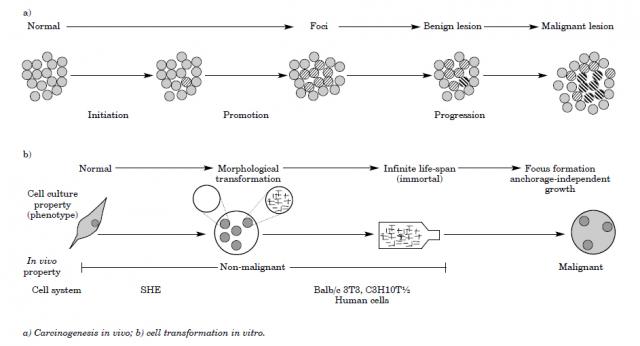Mammalian cell culture systems may be used to detect phenotypic changes in vitro induced by chemical substances associated with malignant transformation in vivo. Widely used cells include C3H10T 1/2, 3T3, SHE, Fischer rat and the tests rely on changes in cell morphology, focus formation or changes in anchorage dependence in semi-solid agar. Less widely used systems exist which detect other physiological or morphological changes in cells following exposure to carcinogenic chemicals. None of the in vitro test endpoints has an established mechanistic link with cancer. Some of the testsystems are capable of detecting tumour promotors. Cytotoxicity may be determined by measuring the effect of the test material on colony-forming abilities (cloning efficiency) or growth rates of the cultures. The measurement of cytotoxicity is to establish that exposure to the test chemical has been toxicologically relevant but cannot be used to calculate transformation: frequency in all assays since some may involve prolonged incubation and/or replating.
Test substances may be prepared in culture media or dissolved or suspended in appropriate vehicles prior to treatment of the cells. The final concentration of the vehicle in the culture system should not affect cell viability, growth rate or transformation incidence.
Metabolic activation: cells should be exposed to the test substance both in the presence and absence of an appropriate metabolic activation system. Alternatively, when cell types are used that possess intrinsic metabolic activity, the nature of the activity should be known to be appropriate to the chemical class being tested.
Positive controls, using both a direct-acting compound and a compound requiring metabolic activation should be included in each experiment; a negative (vehicle) control should also be used.
Several concentrations of the test substance should be used. These concentrations should yield aconcentration-related toxic effect, the highest concentration producing a low level of survival and the survival in the lowest concentration being approximately the same as that in the negative control. Relatively water-insoluble substances should be tested up to the limit of solubility using appropriate procedures. For freely water-soluble non-toxic substances the upper test substance concentration should be determined on a case-by-case basis.
Procedure: cells should be exposed for a suitable period of time depending on the test system in use, and this may involve re-dosing accompanied by a change of medium (and if necessary, fresh metabolic activation mixture) if exposure is prolonged. Cells without sufficient intrinsic metabolic activity should beexposed to the test substance in the presence and absence of an appropriate metabolic activation system. At the end of the exposure period, cells are washed free of test substance and cultured under conditions appropriate for the appearance of the transformed phenotype being monitored and the incidence of transformation determined. All results are confirmed in an independent experiment
Data should be presented in tabular form and may take a variety of forms according to the assay being used e.g. plate counts, positive plates or numbers of transformed cells. Where appropriate, survivals hould be expressed as a percentage of control levels and transformation frequency expressed as the number of transformants per number of survivors. Data should be evaluated using appropriate statistical methods.
